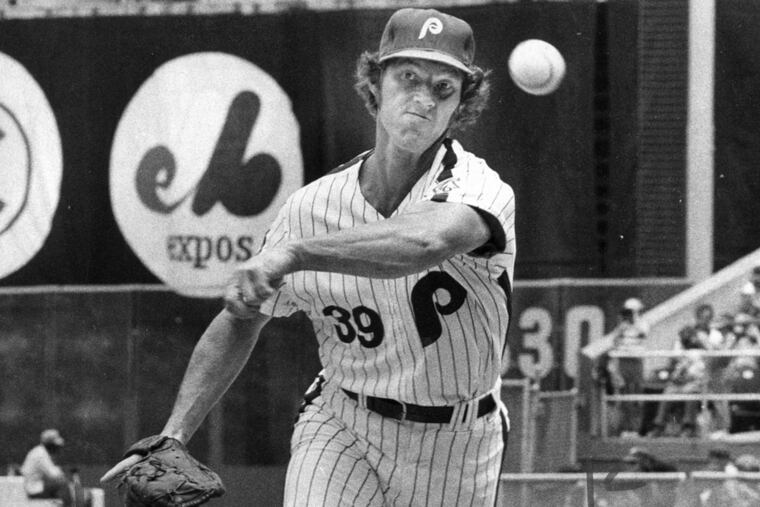Hall of Fame inductee Jim Kaat discusses his Phillies years: He was no fan of Danny O.
The longtime pitcher wonders whether those powerhouse '70s Phillies would have won a pennant with Whitey Herzog.

It wasn’t enough, apparently, for the salary-dumping White Sox to trade Jim Kaat to the Phillies in December 1975. They also offered unsolicited advice for how to bring out the best in the veteran left-hander after back-to-back 20-win seasons in Chicago.
“Chuck Tanner, my manager with the White Sox, said to [Phillies GM] Paul Owens, ‘Pitch him every four days, even every three days if necessary,’” Kaat said Friday. “I wasn’t a power guy. [Tanner] said, ‘The more you pitch him, the sharper he’ll be.’”
Did the Phillies listen?
Not exactly.
“Danny Ozark didn’t take to that philosophy,” Kaat said, referring to the late former Phillies manager. “So I really became kind of a spot starter.”
» READ MORE: Jimmy Rollins is a Phillies legend but falls short of being a Hall of Famer | Scott Lauber
Kaat, 83, will be inducted into the Baseball Hall of Fame next Sunday in Cooperstown, N.Y. Elected seven months ago by the Golden Days Era committee, he will have a Minnesota Twins cap on his plaque. It makes sense. He played 15 seasons for that franchise, including 1959-60 when it was still the Washington Senators.
But Kaat pitched for a total of five organizations in a 25-year run in the majors. And in reflecting on his marathon career — he faced both Ted Williams and Ryne Sandberg — he listed the 1976-78 Phillies as “maybe the best teams, ability-wise” for which he played.
“We were winning 100 games,” Kaat said. “Individually, my years were not good. But as a team and guys I played with and have relationships with, it was a great three years.”
The Phillies went 86-76 in 1975, snapping a seven-year stretch of losing seasons. Their homegrown core of Mike Schmidt, Larry Bowa, Greg Luzinski, and Bob Boone had matured; Dick Allen was back for a Philadelphia encore; Steve Carlton was a full-fledged ace.
By adding Kaat and reliever Ron Reed to a pitching staff that had finished ninth among 12 National League teams in ERA, the Phillies believed they had the finishing touches of a pennant-contending roster.
Kaat agreed. When the White Sox informed him of their intention to move him for prospects, they asked if he had a preference between the Phillies, Pittsburgh Pirates, or New York Mets. Kaat, then 37, cited the Phillies’ upward trajectory — and his father’s fondness for the Philadelphia A’s — as a reason to come here.
» READ MORE: Lucky 17s? How Roy Halladay, Brad Lidge, and Cole Hamels got drafted in the spot where the Phillies pick this year.
Ozark settled on a five-man rotation in 1976 to build in extra rest for 34-year-old Jim Lonborg and Larry Christenson, who had a back problem. That meant fewer innings for Kaat. His workload dipped from 303⅔ innings in 1975 to 227⅔.
Even so, Kaat had a 3.12 ERA through an Aug. 7, 1976, start against the St. Louis Cardinals. The next day, Ozark used him as a pinch runner in the ninth inning. He slid hard into third base and was diagnosed with a hairline fracture of his kneecap. He finished with a 4.53 ERA in his last 12 games.
“With no disrespect to Danny Ozark, he was a coach,” Kaat said. “Well, he was a manager in the minor leagues. But the guys used to sit around and talk, the Phillies of that era, and I think if had we had Whitey Herzog managing that team, we may have gotten to the World Series.”
The Phillies got swept by Cincinnati’s Big Red Machine in the 1976 NL Championship Series, with Kaat allowing two runs in six innings of a Game 3 loss. He pitched a total of 300⅔ innings in 1977 and ‘78, posting a 4.79 ERA, and wasn’t in the postseason rotation for back-to-back NLCS losses to the Los Angeles Dodgers.
Six weeks into the 1979 season, the Phillies unloaded 40-year-old Kaat’s contract on the New York Yankees. He moved on to the Cardinals in 1980 and finally won a World Series under Herzog in 1982, two years after the Phillies won it and 17 years after Kaat won a pennant with Minnesota but lost to the Dodgers in the World Series.
“We came close with the Phillies,” he said. “I definitely thought that we were going to go to the World Series with one of those teams.”
But Kaat did make an impact on Philadelphia sports, even if it wasn’t the type that he expected.
» READ MORE: Weighing the choices facing the Phillies as the MLB draft approaches
For years, Kaat would attend high school basketball games near his home in suburban Orlando, Fla., or during downtime in spring training. In 1973, he marveled at the mountain of a center playing for Maynard Evans High and immediately phoned his friend, Pat Williams, then the Chicago Bulls general manager.
“I said, ‘They’ve got this kid that’s a man among boys,’” Kaat recalled. “And it was Darryl Dawkins.”
Williams got hired by the 76ers in 1974 and dispatched assistant coach Jack McMahon to scout Dawkins. The Sixers picked Dawkins out of high school in 1975, and seven years of shattered backboards followed.
“In hindsight, I wish that Darryl had gone to college, as Billy Cunningham said, because he was such a talent physically,” Kaat said. “But yeah, that was the story I passed on to Pat.”
It’s unlikely to make Kaat’s Hall of Fame speech. But it’s part of his Philadelphia story.